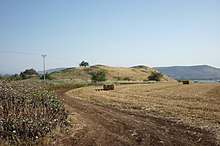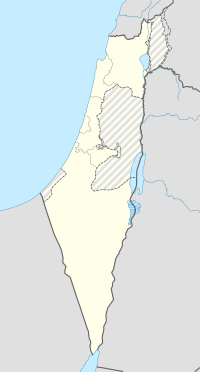| כִּנֶּרֶת | |
 Tel Kinrot (the mound behind the field) from northwest Tel Kinrot (the mound behind the field) from northwest | |
 | |
| Alternative name | Archaeological site: Tel Kinrot (Modern Hebrew), Tell el-'Oreimeh (Arabic) |
|---|---|
| Coordinates | 32°51′38″N 35°30′26″E / 32.86056°N 35.50722°E / 32.86056; 35.50722 |
| Type | Settlement |
Kinneret (Hebrew: כִּנֶּרֶת) is the name of an important Bronze and Iron Age city situated on the northwestern shore of the Sea of Galilee, mentioned in the 14th century BC Aqhat Epic of Ugarit, and in the Old Testament and New Testament. Older Bible translations spell the name alternatively Kinnereth or Chinnereth, and sometimes in the plural as Chinneroth. In time the name became Gennesaret and Ginosar (Hebrew: גִּנֵּיסַר). The remains of Kinneret have been excavated at a site called Tell el-'Oreimeh (Tell el-‘Orēme) in Arabic and Tel Kinrot in Modern Hebrew.
Etymology
"Kinneret"
"Kinnor" instrument
One theory is that Kinneret is derived from kinnor, an ancient Israelite musical instrument, on account of the shape of the lake resembling that of the instrument.
Talmud
According to the Jerusalem Talmud (Megillah 1:1), the name Kinneret is derived from the name of the kinnar trees which grow in its vicinity, explained by lexicographer M. Jastrow to mean the Christ's thorn jujube (Ziziphus spina-christi), and by Moses Margolies to mean cane reeds.
Another Talmud passage says that it is so-called because its fruits are as sweet as those of the kinnara (Ziziphus spina-christi).
"Gennesaret" and "Ginosar"
Adrian Room sees the origin of 'Ginosar' in a combination of Hebrew words, ge ('valley') and either netser ('branch') or natsor ('to guard', 'to watch').
The late-19th-century Easton's Bible Dictionary offers a very different etymology, by stating that the initial Hebrew name 'Kinneret', in the plural 'Kinnerot', was Grecized to Gennesaret, with Ginosar as yet another transformation of the Hebrew name.
Historical use of the name
The lake
Due to its prominence, the city gave its name to the lake (the "Sea of Galilee") for long periods of history, as the Sea of Kinneret, Kinnerot, Gennesaret, or Ginosar.
As other places around the lake rose to prominence, such as Tiberias and Qasr al-Minya, the name of the lake also changed to Lake Tiberias or Lake Minya ("Bahr el-Minya" in Arabic).
The plain
The name has also been used for the "Plain of Gennesaret", which stretches south of the ancient city. The plain's modern names are Plain of Ginosar in Hebrew and el-Ghuweir in Arabic.
Modern settlements
The Israeli Kibbutz Ginosar derives its name from the ancient town, though it is not located on its precise site. The settlements of Moshavat Kinneret and Kvutzat Kinneret are even further south, on the southwestern shore of the lake.
Biblical and other ancient sources
Annals of Thutmose III
| ||||||
| knnꜣrtw in hieroglyphs | ||||||
|---|---|---|---|---|---|---|
| Era: New Kingdom (1550–1069 BC) | ||||||
Kinneret is mentioned as Kennartou in the 15th-century BCE Annals of Thutmose III at Temple of Karnak.
Hebrew Bible
Kinneret was a town allotted to the tribe of Naphtali (Joshua 19:35). The name appears in the singular form as "Kinneret" (Numbers 34:11, Deuteronomy 3:17) or in the plural as "Kinneroth" (Joshua 11:2, 12:3).
New Testament (Gospels)
In the New Testament, the name appears changed to Gennesaret (in Matthew 14:34, Mark 6:53 and Luke 5:1; the latter refers to "the Lake of Gennesaret"). In Matthew and Mark, this city or area is a place where Jesus visited and performed healings. In Luke, he taught the crowds there and appointed his first four disciples.
The Douay-Rheims Bible uses the form "Genesar" in its translation of Matthew 14:34:
- And having passed the water, they came into the country of Genesar.
Josephus and Babylonian Talmud
Flavius Josephus, as well as the Babylonian Talmud mention the lake by the name "Sea of Ginosar" after the small fertile plain of Ginosar that lies at the foot of Tell el-'Oreimeh, ancient Kinneret. Josephus refers to the area as having very rich soil.
Identification and location

The site of the fortified Bronze and Iron Age city of Kinneret is identified with the mound known in Arabic as Tell el-'Oreimeh and in modern Hebrew as Tel Kinrot, halfway between Capernaum and Magdala. Situated on an important trade route, its elevated position meant that it also overlooked and guarded the Plain of Ginosar from its northern end.
The site has the ICS Coordinates: 200805-1252830; ca. 32.87000 N, 35.539312 E.
According to Sugimoto (2015), the Iron Age IB (tenth to mid-ninth centuries BC) cities in the northeastern region of the Sea of Galilee, including Tel Kinrot, likely reflect the activities of the Kingdom of Geshur, mentioned in the Bible. Also, the later Iron Age IIA–B cities here are linked with the southern expansion of the Aram-Damascus kingdom.
History of archaeological exploration
The tell was first explored by Paul Karge in 1911, with a main focus on prehistoric remains. Robert Köppel was the first to excavate (1932 and 1939), but only few results were published.
The premises of the future Mekorot pumping station and a number of spots at the foot of the hill were surveyed in the 1950s by Israeli archaeologists Gershon Edelstein and Bezalel Rabbani (published by Fritz, 1978). In the 1980s, Shan M. M. Winn of the University of Southern Mississippi and Jak Yakar of the University of Tel Aviv cut a small and deep trench near the shore, where they discovered the expected evidence of Early Bronze Age occupation (Winn & Yakar, 1984). Volkmar Fritz of the University of Mainz/Giessen, Germany, then directed the first systematic and continuous excavations: 1982-1985 at the peak ("acropolis"), and in 1995-1999 and 2001 on the lower part of the southeastern slope of the tell (Fritz & Münger, 2002).
In 2002, the Kinneret Regional Project (KRP) took over, continuing the work initiated by Volkmar Fritz on Tel Kinrot, as well as in the wider region around the site (Pakkala, Münger & Zangenberg, 2004). The KRP is jointly run by the Universities of Berne (Switzerland), Helsinki (Finland), Mainz (Germany) and Leiden (Netherlands), and is directed by Stefan Münger, Juha Pakkala and Jürgen Zangenberg. Since 2008 excavations on Tel Kinrot have been "temporarily halted", the KRP team dealing with analysis and publication while continuing the exploration of Horvat Kur and its surroundings.
See also
- Cities in the Book of Joshua
- National Water Carrier, whose Sapir Pumping Station is located at the tell
References
- "Bible Hub, Chinneroth". biblehub.com. Retrieved 2018-11-06.
- Arnold, Bill T.; Beyer, Bryan E. (2002). Readings from the Ancient Near East: Primary Sources for Old Testament Study. Baker Academic. p. 82. ISBN 978-0-8010-2292-0.
- Montagu, Jeremy (2002). Musical Instruments of the Bible, Scarecrow Press, p. 15.
- Marcus Jastrow, Dictionary of the Targumim, the Talmud Babli and Yerushalmi, and the Midrashic Literature, Peabody, Mass. 2006, p. 651 (s.v. כנרא)
- Jerusalem Talmud, Megillah 1:1
- Babylonian Talmud (Megillah 6a)
- Room, Adrian (2006). Placenames of the World: Origins and Meanings of the Names for 6,600 Countries, Cities, Territories, Natural Features, and Historic Sites (2nd, revised ed.). McFarland. p. 138. ISBN 978-0-7864-2248-7. Retrieved 21 February 2011.
- ^ Easton's Revised Bible Dictionary, "Gennesaret"
- Aharoni, Yohanan; Avi, Yonah; Anson, Rainey; Safrai, Ze'ev (1999). Atlas Biblico. Portuguese translation of The Macmillan Bible Atlas. Rio de Janeiro: Casa Publicadora das Assembléias de Deus (CPAD). p. 173. ISBN 85-263-0116-0.
- "Minnim (Khirbet Minya)" at carta-jerusalem.com, 15 May 2012. retrieved 18 December 2021.
- ^ Gauthier, Henri (1928). Dictionnaire des Noms Géographiques Contenus dans les Textes Hiéroglyphiques Vol. 5. p. 205.
- Wallis Budge, E. A. (1920). An Egyptian hieroglyphic dictionary: with an index of English words, king list and geological list with indexes, list of hieroglyphic characters, Coptic and Semitic alphabets, etc. Vol II. John Murray. p. 1048.
- Luke 5:1:NKJV: New King James Version
- Matthew 14:34; Mark 6:53
- Matthew 14:34 in the Douay-Rheims Bible
- The Physical Geography, Geology, and Meteorology of the Holyand by Henry Baker Tristram 2007 ISBN 1593334826 page 11
- Avraham Negev, Shimon Gibson, ed. (2001). Archaeological Encyclopedia of the Holy Land. New York, London: Continuum. p. 285. ISBN 0-8264-1316-1.
- Lamar Williamson 1983 Mark ISBN 0804231214 pages 129-130
- Aharoni, Yochanan. The Land of the Bible, A Historical Geography. The Westminster Press, Philadelphia, 1979, p. 433.
- "עמוד ענן - המדריך השיתופי לידיעת הארץ". amudanan.co.il (in Hebrew). Retrieved 2018-11-06.
- ^ Clément RONZON. "TWCC, The World Coordinate Converter". twcc.free.fr. Retrieved 2018-11-06.
- David T. Sugimoto 2015, History and Nature of Iron Age Cities in the Northeastern Sea of Galilee Region: A Preliminary Overview. ORIENT Volume 50, 2015
- ^ "Tel Kinrot". kinneret-excavations.org. Kinneret Regional Project. Retrieved 6 November 2018.
- KRP homepage, retrieved 25 Sep 2024.
External links
| Sites of the Israelite settlement | |
|---|---|
| Sites involved in the 13th–11th century BCE archaeological phenomenon of the Israelite Settlement | |
| New settlements at previously unoccupied sites in late 13th/early 12th centuries |
|
| New settlements at long deserted sites in 12th/11th centuries |
|
| Destroyed in late 13th/early 12th centuries | |
| Not destroyed in late 13th/early 12th centuries | |
| New Testament places associated with Jesus | |
|---|---|
| Galilee | |
| Judea | |
| Other | |